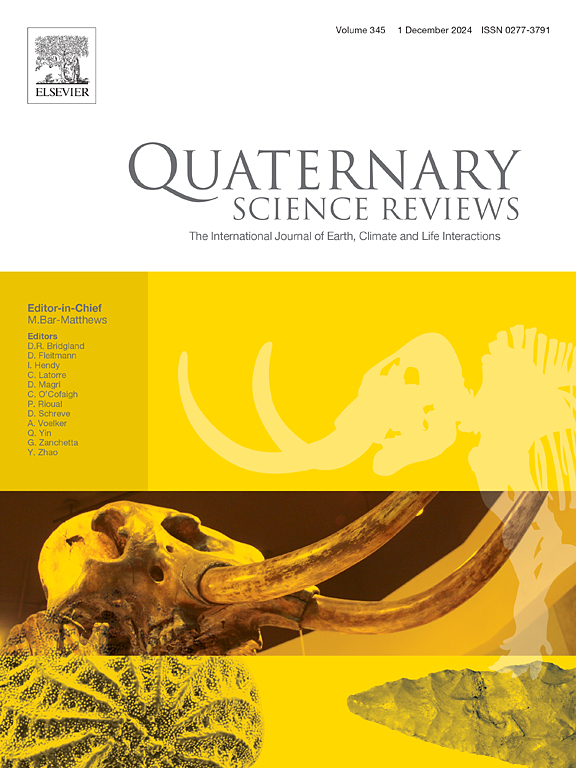Societal responses to cold-season rainfall variability: a speleothem perspective on Byzantine and Hittite climate interactions in Late Holocene Türkiye and southeast Europe
IF 3.2
1区 地球科学
Q1 GEOGRAPHY, PHYSICAL
引用次数: 0
Abstract
Understanding past hydroclimate dynamics of the Eastern Mediterranean is crucial for predicting future climate impacts. However, the ‘Marmara Transition Zone’ in northwest Türkiye, a region of significant societal transformation, lacks high-resolution pre-industrial climate records. Continuous paleoclimate reconstructions are critical to reveal the nature and pattern of Late Holocene hydroclimatic changes and extremes, and to study their impacts on societies. Here, we present a precisely dated and sub-decadal resolution speleothem record from Uzuntarla cave, located near to Istanbul (historically Byzantium and Constantinople), that shows sensitivity to cold-season rainfall amount and seasonality for the Late Holocene. Prior to 2005 CE, stalagmite U-1 reveals two periods of high multidecadal variability of cold-seasonal rainfall in ∼1900-400 BCE and ∼690–1900 CE, separated by a relatively stable phase. This variability aligns with the rise and fall of Byzantine agrarian productivity between ∼350 and 1250 CE, while the most pronounced aridification anomaly in ∼1210-1170 BCE coincides with the collapse of the Hittite Empire (c. ∼1200 BCE), partly linked to regional famine and drought. Our findings indicate that the transition from the Late Bronze Age to the Iron Age in the Marmara Transition Zone was marked by a pronounced shift in the regional climate regime. Namely, that a previously warmer and more stable 'Mediterranean-style' climate shifted toward cooler conditions characterised by increased rainfall variability, and a greater influence of moisture sourced from the Black Sea. Therefore, we suggest that cold-seasonal rains played a critical role in shaping human-climate interactions, power dynamics, and social stability in the Eastern Mediterranean during the Late Holocene. This record offers valuable context for understanding how hydroclimate variability influenced past societies, highlighting the importance of climate as a driver in historical societal resilience and collapse.
社会对冷季降雨变异的反应:从岩浆角度看全新世晚期土尔其和东南欧拜占庭与赫梯气候的相互作用
了解东地中海过去的水文气候动力学对于预测未来的气候影响至关重要。然而,基耶岛西北部的“马尔马拉过渡带”是一个重大的社会转型地区,缺乏高分辨率的工业化前气候记录。持续的古气候重建对于揭示晚全新世水文气候变化和极端事件的性质和模式,以及研究其对社会的影响至关重要。在这里,我们提供了一个精确的年代和亚年代代性的洞穴记录,位于伊斯坦布尔附近(历史上是拜占庭和君士坦丁堡)的Uzuntarla洞穴,显示了对全新世晚期冷季降雨量和季节性的敏感性。在2005年以前,石笋U-1揭示了在公元前1900-400年和公元前690-1900年两个高多年代际变率的冷季降水时期,中间间隔着一个相对稳定的阶段。这种变化与公元前350年至1250年间拜占庭农业生产力的兴衰一致,而公元前1210年至1170年最明显的干旱化异常与赫梯帝国的崩溃(公元前1200年)相吻合,部分与地区饥荒和干旱有关。我们的研究结果表明,马尔马拉过渡带从青铜时代晚期向铁器时代过渡的标志是区域气候制度的显著变化。也就是说,以前更温暖、更稳定的“地中海式”气候转向了更凉爽的条件,其特征是降雨变异性增加,以及来自黑海的水分的更大影响。因此,我们认为寒冷季节降雨在塑造全新世晚期东地中海地区的人类气候相互作用、权力动态和社会稳定方面发挥了关键作用。这一记录为理解水文气候变化如何影响过去的社会提供了有价值的背景,突出了气候作为历史社会恢复和崩溃驱动因素的重要性。
本文章由计算机程序翻译,如有差异,请以英文原文为准。
求助全文
约1分钟内获得全文
求助全文
来源期刊

Quaternary Science Reviews
地学-地球科学综合
CiteScore
7.50
自引率
15.00%
发文量
388
审稿时长
3 months
期刊介绍:
Quaternary Science Reviews caters for all aspects of Quaternary science, and includes, for example, geology, geomorphology, geography, archaeology, soil science, palaeobotany, palaeontology, palaeoclimatology and the full range of applicable dating methods. The dividing line between what constitutes the review paper and one which contains new original data is not easy to establish, so QSR also publishes papers with new data especially if these perform a review function. All the Quaternary sciences are changing rapidly and subject to re-evaluation as the pace of discovery quickens; thus the diverse but comprehensive role of Quaternary Science Reviews keeps readers abreast of the wider issues relating to new developments in the field.
 求助内容:
求助内容: 应助结果提醒方式:
应助结果提醒方式:


